This year has seen toy companies embrace feathered dinosaurs like never before, if not always with perfect execution. Accuracy stalwarts like Safari Ltd and especially Kaiyodo have been giving us feathered dinosaurs for years, but now even Papo and Schleich are getting on the plumage train. Another late convert is Japanese company Colorata. Colorata, named after the specific epithet of a butterfly, is best-known for exquisitely rendered PVC figurines of extant animals. They have also produced several sets of prehistoric animals, some of which are very nice–in particular, they have made some beautiful pterosaurs. To date, however, their only feathered dinosaur has been Archaeopteryx from their “Dino Jurassic” boxed set. Their two “Dino Cretaceous” boxed sets are still in production, and feature featherless versions of animals like Velociraptor and Deinonychus. This year, finally, they have released their largest prehistoric set yet: the Premium Feathered Dinosaurs box.
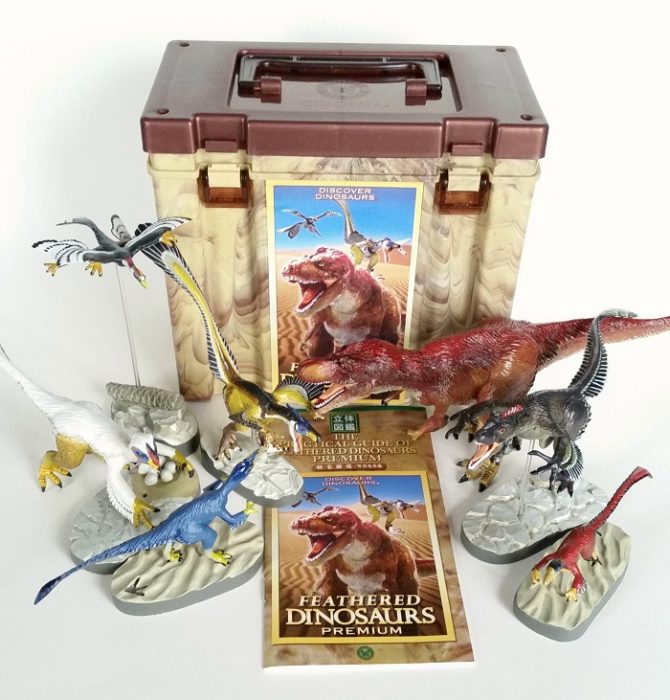
This set features seven different animals known or hypothesized by inference to have feathers. The first thing to note is that these figures are much larger than previous releases from Colorata. The sculpts are all lovely, but they contain errors that will irk the more accuracy-obsessed among us. Let’s take a look at each.
First up: Tyrannosaurus. To my eye, this is a believable quantity of feathering, leaving bare the few areas known from skin impressions to have borne scales. Incidentally, although all seven of these figures come with bases that they balance on with the help of acrylic support rods, this is the only figure in the set that stands solidly on its own off the base. This is by far the largest dinosaur Colorata has made, about 20 centimeters long, or around 1:55-1:60 scale. The tail comes in a separate piece and attaches unobtrusively.
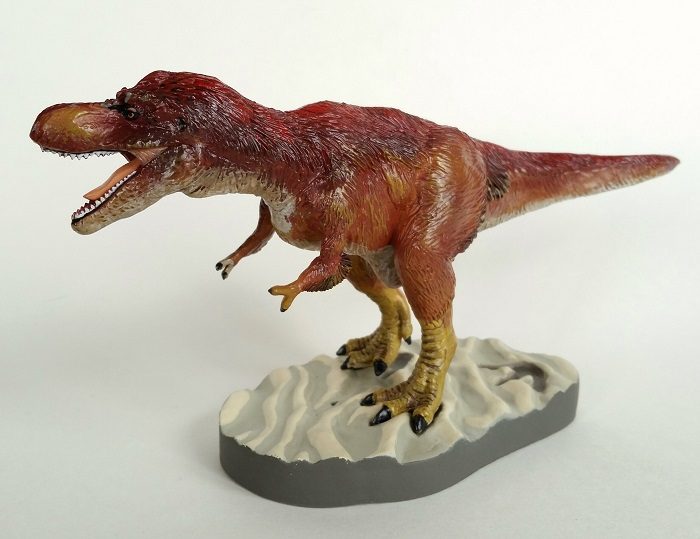
Next up is Oviraptor, though the head, like most other figures of this genus, seems to be modeled after Citipati. It’s about 14 cm long, around 1:15 scale. The white color scheme with the tan belly and legs is a daring choice, but I think it works. As has become de rigueur for Oviraptor, there are brighter colors around the face. The hands are sculpted in the correct orientation, and spread out–and naked. Fossils of close relatives of Oviraptor such as Caudipteryx and Similcaudipteryx show that it would have had vaned feathers that extended onto the digits, not stopping at the wrist as on this figure. This omission mars an otherwise attractive figure, as well as several others in the set.
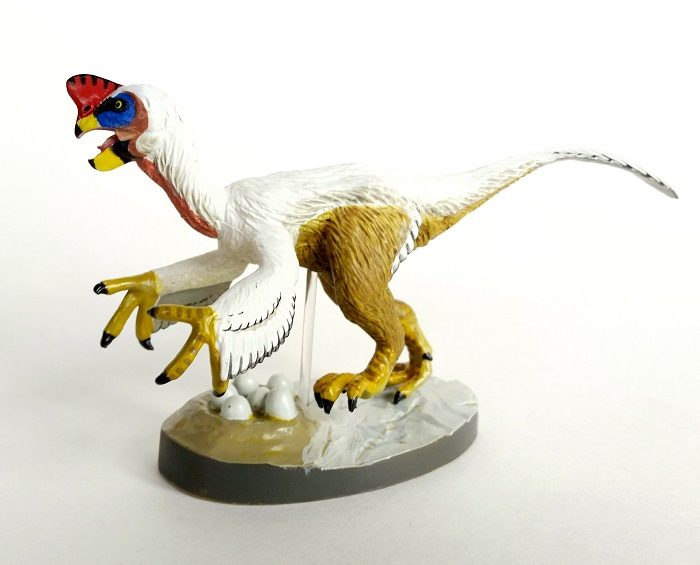
Like this Deinonychus. This is one of the finest plastic models of the genus ever made, recreating the dynamic pose of the earlier, and smaller, featherless version. Nevertheless, the hands are missing the primary feathers that Deinonychus is almost certain to have had, and the body feathers adhere to the underlying form too closely, giving the animal a slightly wet look. This figure is larger than the previous Colorata version, coming in at around 1:20 scale.

The Velociraptor follows more or less the same pattern: larger than the previous incarnation (a bit over 11 cm long, 1:18 scale), with feathers, but not enough feathers. The feathers along the arm flex with the wind under the animal as it jumps, a nice touch, but the hands are again glaringly naked. This won’t spoil it for everyone, but it might prove intolerable for those who are sticklers for complete feathering. At the same time, for the moment, maniraptorans with 100% accurate feathers are pretty thin on the ground.
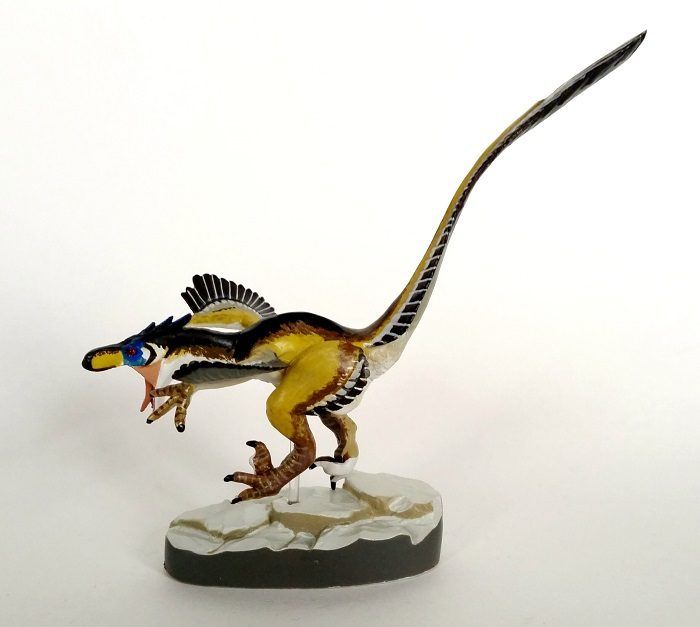
The Dilong fares a bit better. It’s more distantly related to birds than Deinonychus or Oviraptor are, and the basically hairlike feathers look believable here. This might be my favorite of the set, perhaps in part because of the blue coloration. It’s a species that Colorata hasn’t attempted before, and it comes in at about 11 cm long, or 1:18 scale.
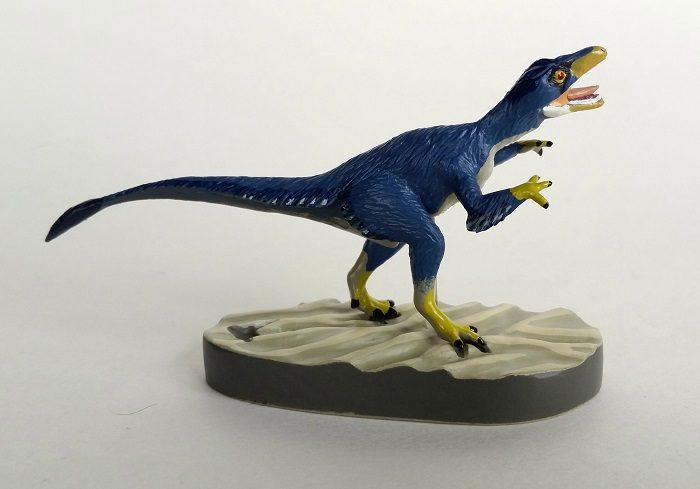
Sinosauropteryx was one of the discoveries that convinced skeptics that feathers must have been fairly widespread among theropods. Its feathering reflects the distribution seen in the fossil, and its position in the family tree of coelurosaurs, more distant from birds. This is one of the few fossil animals from which we know a little bit about the color pattern, and remains suggest that it had bands of reddish and white on the tail, which would have looked nice on this figure. But the part that bothers me is that it has a strong overbite. It might just be a molding error, but the lower jaw is much too short, making it look just a tiny bit goofy. This figure is just a shade bigger than the Kaiyodo version, about 1:13 scale.
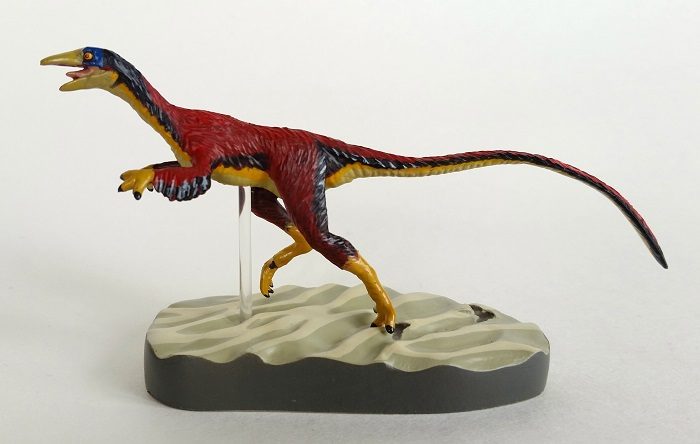
The Microraptor is another attractive sculpt, with a beautiful base featuring a cycad trunk. But like its larger relatives, it suffers from incomplete feathering on the hands, and a slightly misshapen tail. Finally, studies of fossilized melanosomes (subcellular structures that store dark pigments) suggest that the black coloration on Microraptor was more extensive. Still, an elegant little figure if you can look past those flaws. It’s about 7 cm long, or about 1:13 scale.

Some previous Colorata releases have featured pegs on the feet of the animals, with holes in the bases to receive them. Thus, the animals couldn’t stand on any other surface. Most of the new ones don’t stand well on their own, either, but the fact that they don’t have foot pegs makes them much less distracting when removed from the bases for play time. In that sense, and in the sense that they are at least a good-faith effort at feathering, these are an improvement over previous Colorata versions of theropods. However, there are more accurate versions of almost all of these animals available, and the price tag of this set is commensurate with the larger-than-usual figures (about the equivalent of $70 USD in Japan, and up to twice that much elsewhere). If you’re willing to shell out for them, and you don’t mind a few reconstruction mistakes, you can find them on auction sites, or get them from a retailer that deals in Japanese imports or exports.
Disclaimer: links to Ebay and Amazon on the DinoToyBlog are affiliate links, so we make a small commission if you use them. Thanks for supporting us!




I finally got this set and I’m very happy with it! I’m no longer bothered by the reduced feathering on the forelimbs of the pennaraptorans. The Velociraptor, Deinonychus and Oviraptor are all pleasing in their own way and I’m happy to have these figures of them that are in a smaller scale. My favourite figure of this set though is the Dilong, I think it’s the best figure of this species. The Tyrannosaurus is nice, but I don’t need a feathered version of this animal. And this brings me to the disappointing figures of the set, the Microraptor and Sinosauropteryx. They have nice qualities, but their feathering doesn’t match the known feathering of these animals, and the Microraptor’s feet and Sinosauropteryx’s head are overly simplified and just don’t look good. I’m happy to have more than half of the figures in this set though, so it was worth getting!
[…] has produced several sets as part of their larger “Real Figure Box” line. The recent Feathered Dinosaurs set has been covered previously here on the Dinosaur Toy Blog, but let’s take a look at their […]
The Oviraptor, Deinonychus and Velociraptor all appear to have wing feathers at the back of the upper leg, which looks weird to me. I think I remember reading that since feathers are metabolically expensive to produce, when they don’t serve a purpose in a more complex form they are evolved into simpler feathers. I don’t find it convincing that those dinosaurs would have minimal wing feathers on their legs. I don’t know of any extant bird that has the kind of minimal leg wing feathers those Colorata figures have.
In addition to the Sinosauropteryx figure not having the colouration bands seen on the tail in fossils of this animal, specimens of Sinosauropteryx show the tail feathers don’t extend into a tail fan like on this figure. Is the underside of this figure’s tail featherless? If it is that would also be inaccurate, as specimens of Sinosauropteryx show the underside of their tail is feathered. I agree the figure’s lower jaw is too short. Its upper jaw is also much too shallow! It also looks like the figure lacks the large claw on the first finger of Sinosauropteryx.
The Microraptor figure appears to lack the larger claw on the second toe.
I hadn’t noted that, but in fact all but the Microraptor have ruffs at the back of the thigh. I suppose if they were used as display structures they could be produced, even if costly, considering that they are not constrained by having to fly with them. But I agree that that’s not the most parsimonious interpretation.
Looking back at it now, I feel I was too harsh on this Colorata set. I now appreciate it and think it is quite good!
Something about the velociraptor reminds me of the bullyland one…
I love how dynamic the Deinonychus and the Velociraptor look.